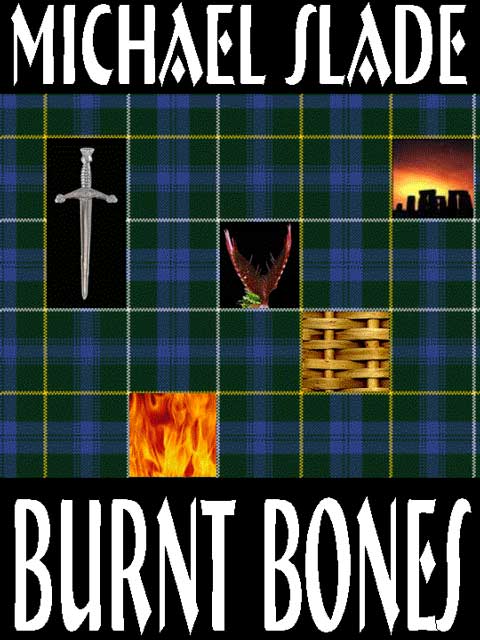Slade's Morgue:
Burnt Bones


Bonehenge
Canadian edition of BURNT BONES
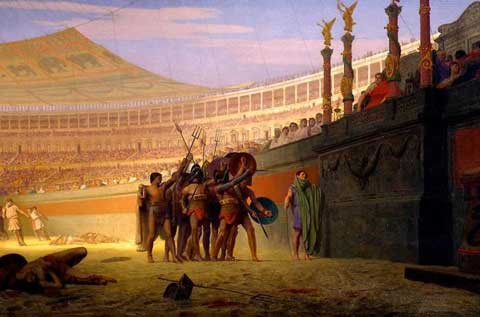
AVE CAESAR MORITURI TE SALUTANT by Jean-Leon Gerome (1859)
BURNT BONES is Michael Slade's first Mephisto thriller. Here's the story behind it.
Whether it's Professor Moriarty vs. Sherlock Holmes...
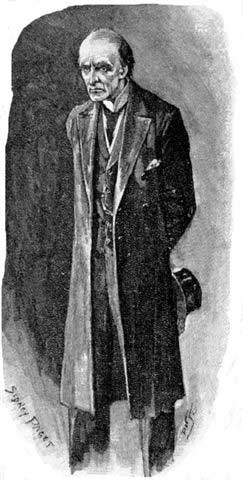
Moriarty by Sidney Paget
Or the Joker vs. Batman...

Joker by Jerry Robinson
Or Flattop vs. Dick Tracy...

Flattop by Chester Gould
Or Ernst Stavro Blofeld vs. James Bond...

Donald Pleasance as Blofeld
Or the Deaf Man vs. the 87th Precinct...

The Deaf Man
...Slade got hooked young on the fiendish schemes hatched by recurring archvillains.
By BURNT BONES - his 7th thriller - it was time to give the psycho-hunters of Special X an ongoing uber-nemesis.
Slade conceived Mephisto as a malignant narcissist, with psychopathic features, paranoid traits, ego-syntonic aggression, and no conscience.
Mephisto has an obsessive-compulsive need for power, fueled by delusions of greatness. He's a man on a mission to rid the world of overpopulation to save mankind from itself. Borderline psychotic, he relishes cruelty and is a vindictive sadist. The higher the body count resulting from one of his schemes, the more it serves his nefarious purpose.
Mephisto, in short, is a nasty piece of work.
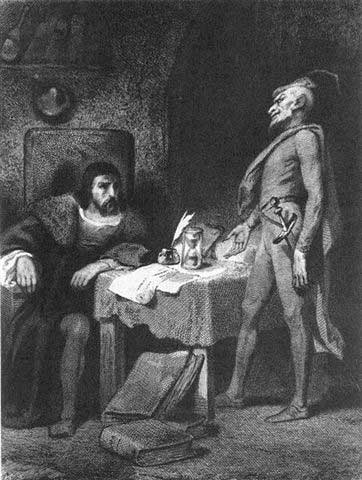
Mephisto and Faust by Tony Johannot (about 1845)
In Marlowe's DOCTOR FAUSTUS (1604) and Goethe's FAUST (1808), both based on a classic German legend, the title character is locked in combat with Mephisto - Mephistopheles - for his soul. Foolishly, Faust made a pact with that devil, sealed in blood, by offering his soul in exchange for unlimited knowledge.

Sealed in blood
(Poster for magician Harry Kellar, 1849 - 1922)
By embarking on his first doomsday scheme, megalomaniacal Mephisto locks arms with C/Supt. Robert DeClercq. Their "pact" is sealed in blood by the madman's crimes. In exchange for DeClercq's "soul" (by destroying everything the Mountie values), Mephisto taunts him with the "knowledge" in baffling clues.
It's a one-way pact with the devil spawned by toxic psychology. A malignant narcissist needs a worthy opponent to crush under his supremacy.
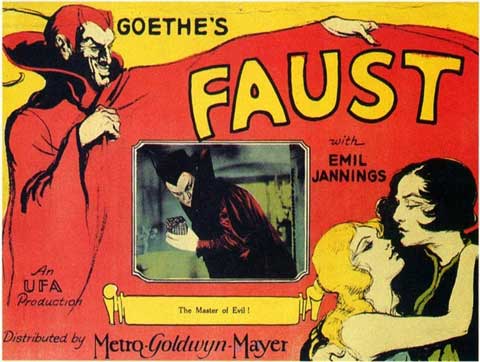
"The Master of Evil!"

"Terrified, she waited."
Slade's Mephisto looks nothing like that red devil. Instead, he's a chameleon cloaked in the disguise of his current obsession. Break that fixation and he will shed his external "skin," only to reappear later in a different disguise dictated by his next compulsion...and an added lust for revenge.
With each thwarting obstacle, his hate-driven, implacable vendetta ratchets up.
A malignant narcissist has an inferiority complex. Rejected, bullied, abandoned, or sexually abused in his formative years, he overcompensates with grandiose designs. So severe was the trauma in Mephisto's youth that he has erased all memory of who he really is.
Mephisto's akin to a free-floating parasite hunting for a self-defining host. In BURNT BONES, his mega-death fixation locks on Stonehenge.
Can you guess why?

Stonehenge, 1400 B.C. (U.K. Ministry of
Public Buildings and Works)
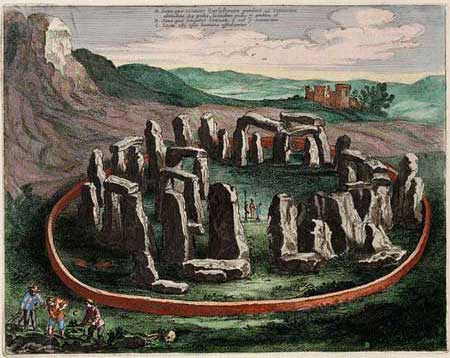
Stonehenge, 1649 A.D.
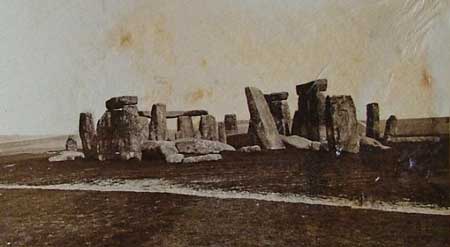
Stonehenge photograph, 1877

Stonehenge today

Stonehenge at the summer solstice
(Photo by Andrew Dunn, licensed copyright)

Druid priests hold a sacrifice at Stonehenge
Note the approaching Romans

HUMAN SACRIFICE BY A DRUID by Felix Philippoteaux (1851)
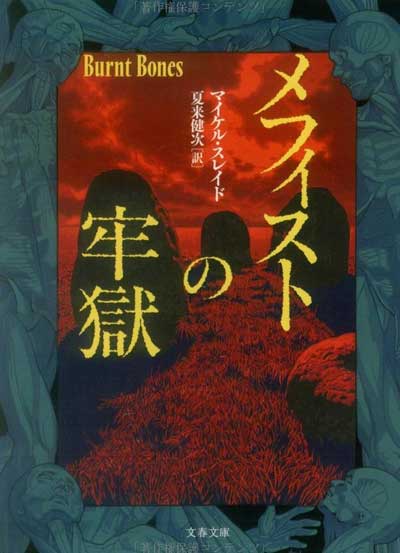
Japanese edition of BURNT BONES
The Millennium is upon us, and with it a new kind of killer.A killer fit for the New Dark Age.
Chief Superintendent Robert DeClercq of Special X - the Special External Section of the Mounted Police - has faced a horde of psychos in his time. But never one as coldly diabolical as Mephisto.
Mephisto sends his deadly challenge to DeClercq from cyberspace. Somewhere out there lurks a hellish mastermind, a sadistic psychopath obsessed with the past, for whom torture and murder are black arts in a deadly quest to discover the secret of Stonehenge.
What the devil is Stonehenge? Through two million dark nights that mysterious puzzle has baffled mankind. Mephisto suspects the answer lies in the Highland Hoard - a mythic cache supposedly secreted by barbarian raiders on Hadrian's Wall - which also reveals what must be done to save mankind from the horror to come.
Backed by Donella, a femme fatale as warped as he is, and a cult of modern sacrificing Druids, Mephisto uses DeClercq as a pawn in his maniacal quest to uncover the treasure. Trapped in a life-or-death race to save a captive from dying the most horrible death imaginable, DeClercq and his team must use 21st century forensics to prevent Mephisto from using the secrets of the past to shape a future hell on Earth.
The answer to the riddle of Stonehenge?
BURNT BONES.

"This psycho's a hoot! And every bit as satisfying as one might hope. HEADHUNTER, GHOUL, CUTTHROAT, RIPPER - a list of some of the previous titles should give you a fair idea of the kind of beasts Slade's psycho-hunters have to battle. BURNT BONES introduces the psycho to end all psychos. Mephisto makes Hannibal Lecter seem like an Oxford don with slightly unorthodox culinary tastes. Not satisfied with one maniac, Slade gives Mephisto a diabolical partner, Donella. The pair torture and slaughter West Coasters belonging to the Campbell clan in a bid to discover the whereabouts of the Scottish Highland Hoard, a mysterious cache that's supposed to provide the key to Stonehenge and give the unholy duo the power to wreak ultimate horror upon the planet. To add more spice, we also get - in the inimitable Slade tradition - vivid history featuring Druidic Britain and Ancient Rome, the great archeological exploits of all time, and a cornucopia of B.C. and Washington State coastal-island lore. How does he cram it all into 405 pages?" - The Vancouver Sun
"If you like your murders gory and in bulk, this is the series for you. Slade is one of the few writers I've found who can match Lawrence Block and Andrew Vachss scare for scare. The story begins with the abduction of two elderly men, both named Campbell. One is buried alive in a grave, with enough oxygen to keep him alive and screaming; the other is buried under several fathoms of sea, also with an air tank to keep him breathing and terrified. Above ground, surrounded by his Druid henchmen, Mephisto whispers in each Campbell's ear: 'Where is the Hoard?' Reveal the secret and go free? Die quick? It's up to Special X and profiler Kim Rossmo to unravel the web of a millenarian cult gone mad. Slade writes the kind of stuff of which nightmares are made." - The Globe and Mail
"BURNT BONES is a very original thriller - nice and gory, with plenty of scenery-chewing scenes - that should appeal to anyone looking for a change from the usual stuff that litters bookstore shelves." - The Halifax Chronicle-Herald
"Mephisto's female partner, Donella, is a sexual amazon with the tenderness of a cobra. Mephisto's bodyguards, complete with blue faces, are impersonal killing machines, acting out the roles of demonic Druids. Their favorite diversion is to burn people alive in wicker cages. Slade's careful research into the clans of Scotland and the mystery of Stonehenge are well-handled, as is his description of new police techniques for catching serial killers. The job of a criminal lawyer is good training for writing complex, detailed stories. The inevitable horrors that befall many of the characters in BURNT BONES are in stark contrast to this peaceful island paradise. Let's face it, you either like fantastic characters in a setting of blood and human BBQs, or you don't. Fans will not be disappointed." - Island Tides

Mephisto (off page) and Donella, his Highland Queen
Slade's fascination with all things Roman - and particularly gladiators - goes back a long way. Here he is, at age 8, and on the right, in his secutor ("pursuer") or murmillo (from the "fish-shaped helmet") gladiator costume. The neighbors were treated to the bloodshed of the Colosseum on their front street.

By age 9, Slade was drawing GLADIATOR COMICS.
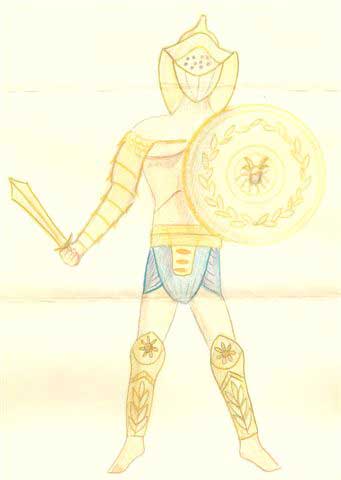

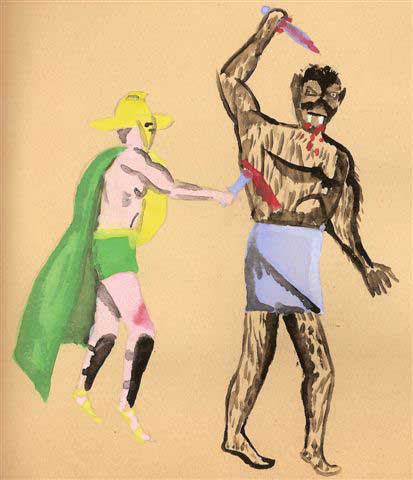
THE GLADIATOR vs. THE THING IN TUTANKHAMUN'S TOMB
Note the superhero cape
Note the Egyptian stance and loincloth of the Thing
Slade's career in the neighborhood Colosseum was not short-lived. Here he is, age 12, as a retiarius ("net man"). Despite its blunt tip, his trident drew blood, and parental displeasure from too many wounds earned him his rudis (wooden retirement sword).
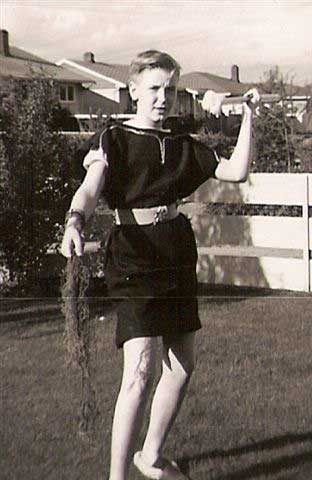
Fortunately, the Hungarian Revolution (1956) sent a wave of refugees to Vancouver. Hungarians are master fencers, and they met on Friday night in the gym of a downtown school. For his birthday, Slade's mom bought him a fencing foil and face mask. Every Friday, he would sit on a bench and watch the swordsmen fence. Finally, the Master - a very old man - came over and asked him in a thick accent, "You wish to learn to fight?" When Slade nodded enthusiastically, the old man's index finger crossed him like a priest's, dividing his chest into defense quadrants.
"Come," he said. "We fence."
C/Supt. Robert DeClercq, you'll note, is a fencer.
The following year (see BLOG: "How I Spent My Summer Vacation"), Slade switched from drawing comics to writing 13 TOMBES.
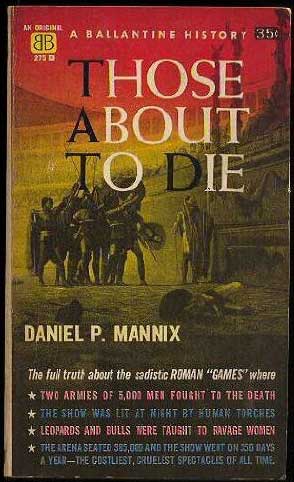
In 1958, Daniel P. Mannix published this book with all the gory details of the Roman Colosseum. Not only did it spark the plot that would become BURNT BONES, but screenwriter David Franzoni also credits it with inspiring his script for GLADIATOR (2000), the Ridley Scott and Russell Crowe film.
The Mannix cover and title were taken from the Gerome painting near the top of this Morgue drawer. AVE CAESAR MORITURI TE SALUTANT translates as "Hail, Emperor! Those who are about to die salute you!" Jean-Leon Gerome (1824 - 1904) is still the best Roman Games artist. His POLLICE VERSO painting below - translation "Thumbs Down" - inspired Ridley Scott to direct GLADIATOR. "That image spoke to me of the Roman Empire in all its glory and wickedness. I knew right then and there I was hooked."

POLLICE VERSO by Jean-Leon Gerome (1872)
A murmillo has his foot on a retiarius

THE GLADIATORS, statue by Jean-Leon Gerome (1878)
In 1960, SPARTACUS was released. Thirteen-year-old Slade saw it umpteen times in the theater.



So, was it inevitable that Slade would write a gladiator novel?
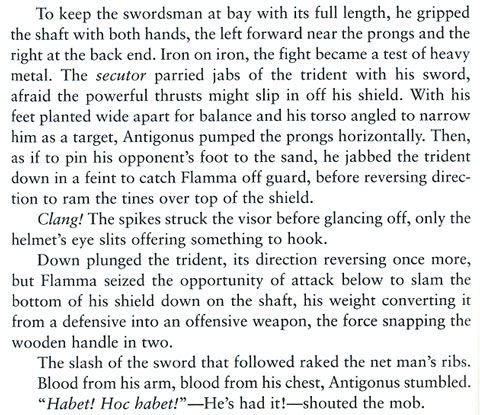
In Grade 7, Slade studied Ancient Rome in school. The following year, for Easter break, his Mom took him to Britain. The flight was 13 hours on a plane like this:

TCA Super Constellation
Unable to sleep on a plane, Slade read this book through the long night...
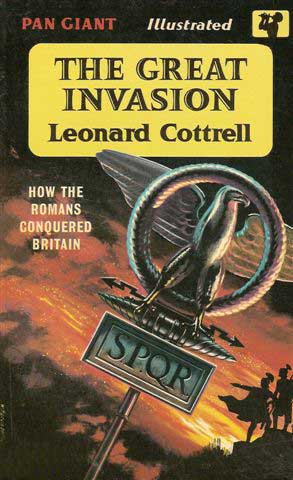
...and when the Super Connie broke through the clouds over Britain at dawn the next morning, Slade imagined this on the English Channel below.

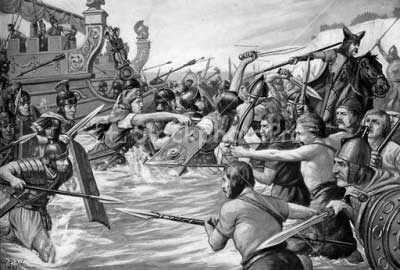
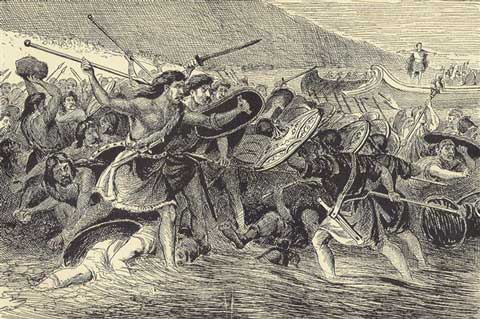
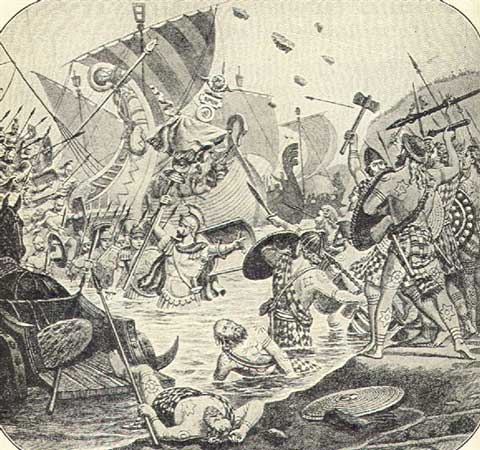

JULIUS CAESAR AND STAFF by Jean-Leon Gerome (1863)
Julius Caesar invaded Britain in 55 B.C. His adversaries were the Celts, and their priests, the Druids. Two thousand years separate today from that invasion, and 2,000 years separated Caesar from the building of Stonehenge.
Who built Stonehenge and why remains a mystery. It was there when the Celts arrived a few hundred years before the Romans, so the Druids usurped Stonehenge for their ritual sacrifices. On the flight to Britain, young Slade read this quote from Caesar:
"Some tribes have colossal images made of wickerwork, the limbs of which they fill with living men. They are then set on fire, and the victims burnt to death."



So, what better opening for BURNT BONES?
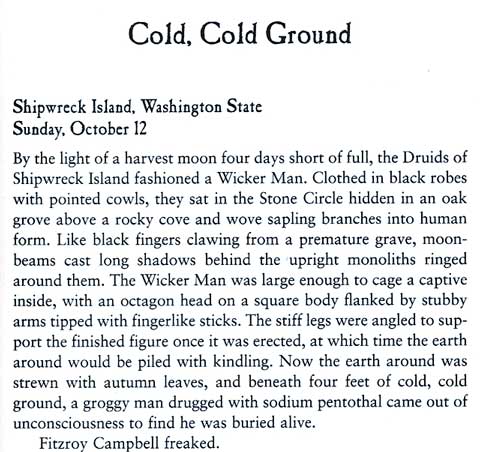
A century after Caesar, the Romans returned to conquer Britain in 43 A.D. On the island of Mona - now Anglesey - in northwest Wales, they massacred the Druids, destroyed their shrine, and cut down their sacred oak and mistletoe groves.
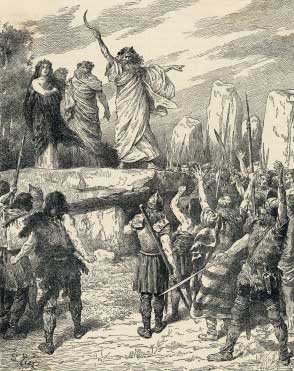
Druids incite Celtic opposition to the Romans
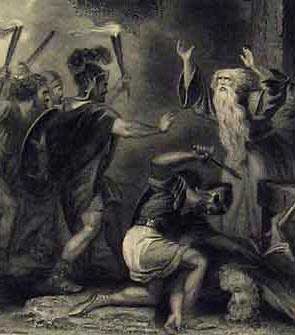
After defeating Boudica and the revolt of the Iceni...


...the Romans pressed north into what's now Scotland...
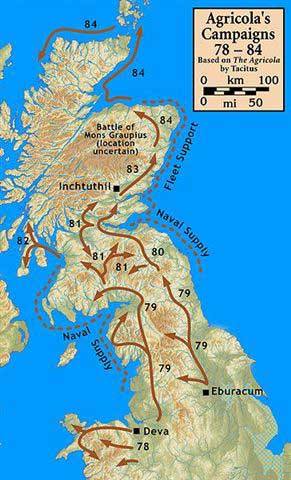
...to conquer Slade's headhunting ancestors.

A male Pict

A female Pict
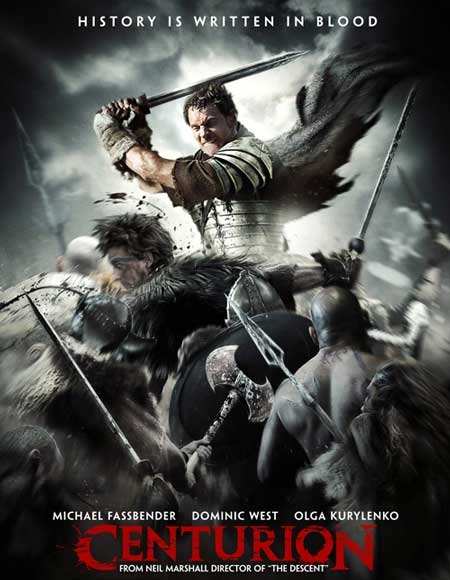

CENTURION (2010)


Calgacus ("Possessing a penis") leads the Highlanders at Mons Graupius
Despite defeating the Highlanders at the Battle of Mons Graupius, the Romans couldn't suppress them. Legend says the Ninth Legion vanished in "Scotland" around 117 A.D. True or not, construction began on Hadrian's Wall in 122 A.D., and from then until the Romans left Britain in 410 A.D., that defensive barrier from what is now Carlisle to Newcastle marked the northern frontier of the Roman Empire.

BUILDING THE ROMAN WALL by William Bell Scott (1856)

The Picts considered the human head a source of spiritual power, so collecting "brain balls" guarded them from supernatural harm. For centuries, marauding barbarians from the misty outland to the North sporadically raided Hadrian's Wall for silver and Roman heads.
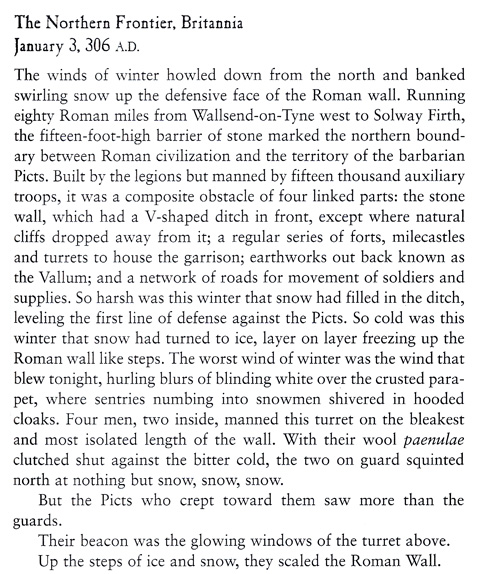
Oh, to be a young man in the late 1960s! Slade spent the Summer of Love (1967) backpacking through Europe on about $2 a day. All the way to Cold War Moscow (by train) and every country west. In London, he bought the hot books on Stonehenge at Foyle's Bookshop in Charing Cross Road...

Archeoastronomy
...then hopped a train west to Salisbury Plain.

STONEHENGE AT SUNSET by J.M.W. Turner (1812)
Back then, pilgrims were free to wander through and around the stones. The restricting fence didn't come until the 1970s. As well as studying Ancient Rome at university, that was the year that Slade delved into the Romantic poets. Can you vision him with Hawkins' book in hand and Wordsworth's verse in mind...
Pile of Stone-henge! So proud to hint yet keep
Thy secrets, thou lov'st to stand and hear
The plain resounding to the whirlwind's sweep
Inmate of lonesome Nature's endless year.
...tracking how archeoastronomical sunrays stab through the stones...
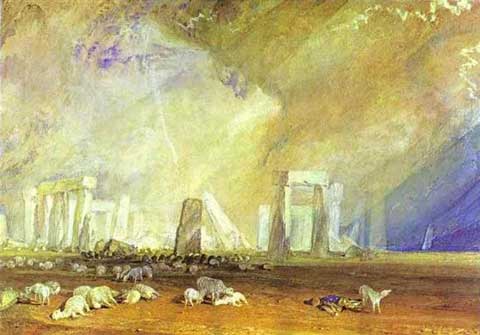
STONEHENGE by J.M.W. Turner (1828)
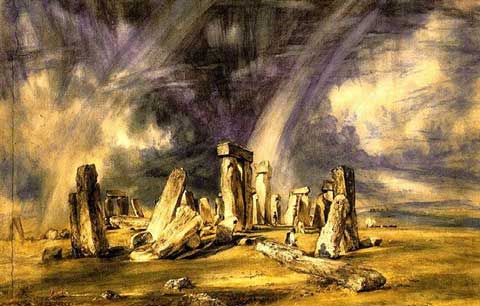
STONEHENGE by John Constable (1836)
...and stretching out on the ground in the center of the megalith to stare up at the sky?

Stonehenge by fish-eye lens (licensed copyright)
The museums of Britain are full of treasures recovered from buried hoards. The Celts, Romans, Anglo-Saxons, Vikings, and Normans launched successive invasions. Defenders would gather and hide their possessions from rampaging looters, and if they died, centuries could pass before the hoard was found.
The Salisbury Hoard is the largest cache of prehistoric metal objects ever unearthed in Britain. The Hallaton Treasure dates back to Iron Age generations before and after the Roman Conquest. Note the cryptic symbols on these coins. What do they mean?
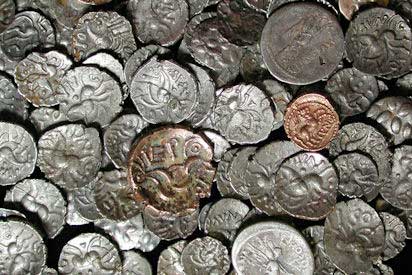
The Hallaton Treasure

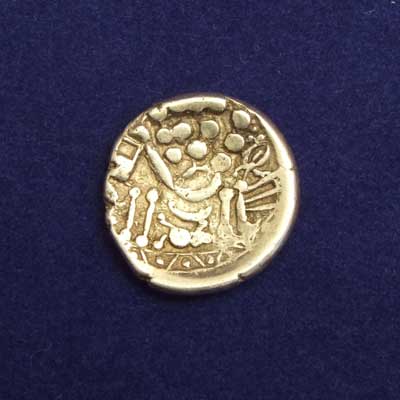
Sometimes, buried treasure comes in human form.

Lindow Man
Lindow Man (nicknamed Pete Marsh) was found in a peat bog near Cheshire, England in 1984. Sometime between 200 B.C. and 100 A.D., he fell victim to the "triple death": three blows to the head, strangulation with a knotted cord, and his throat was cut. His stomach contained burnt cereal and mistletoe pollen.
So, was Lindow Man a Druid sacrifice?
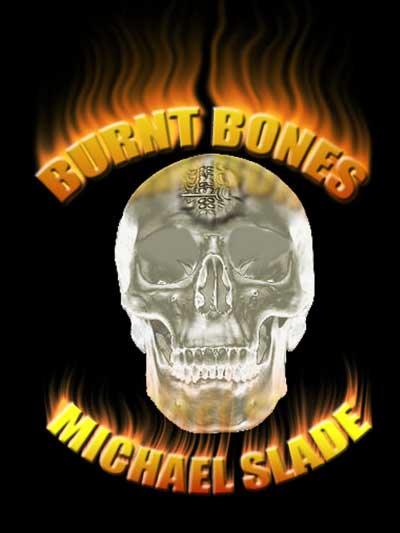
The Silver Skull in BURNT BONES evolved from that historical jigsaw. Slade's plot, however, required that the Highland Hoard be lost, not found.
In 1978, the two collaborators on the early Slade novels embarked on a 3,350-mile road trip around Britain. No main roads, just the ancient byways. They alternated driving, and the navigator constantly read aloud from the AA ILLUSTRATED GUIDE TO BRITAIN. Bed-and-breakfast was a standard 1 pound a night. From London, to Land's End, to Wales, and north to John o' Groat's, the days involved countless stops at historical landmarks, and the nights were spent talking to locals in legendary pubs.
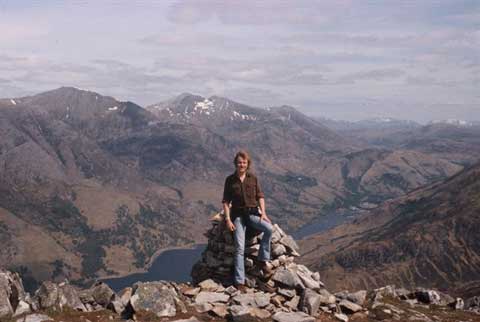
Slade in the Highlands of Glencoe
On his mother's side, Slade's ancestors were a branch of the Clan MacDonald. As early as the 1300s, the MacDonalds championed a Highland kingdom independent of the Lowland Scots and England. The Clan Campbell sought power and wealth by aligning with those adversaries. Enmity between the clans is known as the Great Feud.
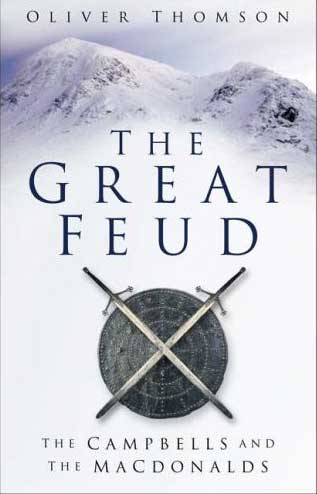
On February 13, 1692, the Great Feud reached its boiling point at the Massacre of Glencoe. Under the long tradition of Highland hospitality, Captain Robert Campbell of Glenlyon and his troops were billeted for two weeks in winter by Clan MacDonald of Glencoe.
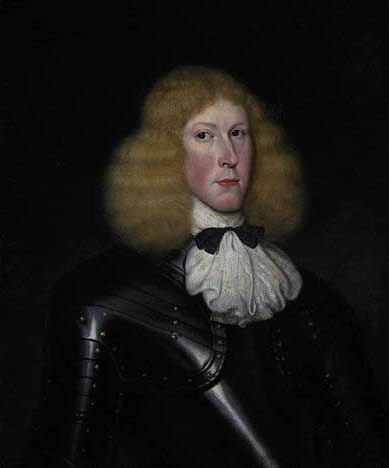
Captain Robert Campbell of Glenlyon
On February 12, Captain Campbell received orders "to fall upon the rebels, the McDonalds of Glenco, and put all to the sword under seventy. You are to have a special care that the old Fox and his sons doe upon no account escape your hands. This is by the Kings speciall command, for the good & safety of the Country, that these miscreants be cutt off root and branch."

Campbell's orders
Early next morning, 38 men, women, and children were slaughtered in or fleeing from their homes. And 40 more MacDonalds soon died of exposure.


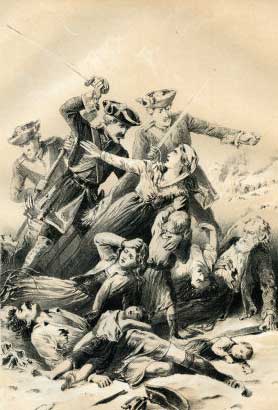

MASSACRE OF GLENCOE by James Hamilton (1883 - 1886)
Cam-beul - MacDonalds will tell you - means "twisted mouth" in Gaelic. "Never trust a Campbell!" is a common refrain. Murder was bad enough in Scots law, but "murder under trust" - killing those who offer you Highland hospitality - was heinous. "No hawkers or Campbells" reads the sign on an inn in present-day Glencoe.
In truth, Slade never met a Campbell he didn't like. But he wasn't about to let that spoil a good plot device.

Culloden Moor
The Highland clans were crushed at the Battle of Culloden in 1746. As usual, their formation was the "Highland charge," a horde of screaming warriors dashing full tilt at the enemy. Employing a deadly new tactic, each Redcoat thrust his bayonet at the Scot on his right - instead of straight ahead - to bypass the Highlanders' shields.
Again, the Campbells fought with the English, whose leader, "Butcher" Cumberland, had the wounded put to death.
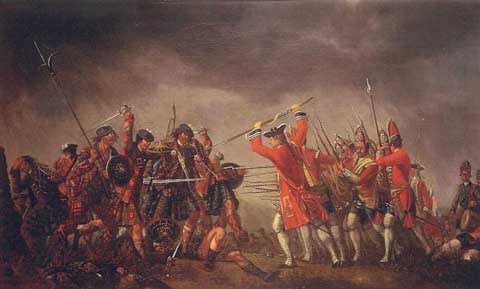
THE BATTLE OF CULLODEN by David Morier (1746)
Defeat at Culloden brought the Highlands under British rule. Clan chiefs were stripped of their estates, and kilts and tartan were banned. Finally, the Highland Clearances - the forced displacement of Scots in the 18th and 19th centuries - prompted mass emigration to North America.
Legend says the Highland Hoard was stolen from MacDonalds during the Glencoe Massacre, then exported by Campbells who emigrated to British Columbia.
If so, Mephisto wants it.
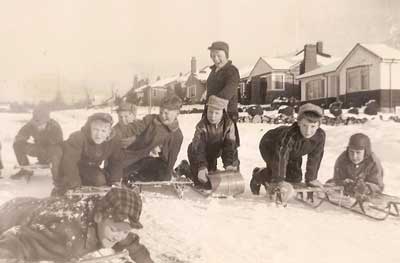
"Rosebud" (1956)
If you live in a snowy climate, you might have a photo like this. It could be the opening of IT'S A WONDERFUL LIFE (1946) or CITIZEN KANE (1941). Slade is second from the left, behind the boy in the checkered hat. His best friend Gordie, laughing, is patting his back.
Whenever Slade sees an old photo like that, it makes him wonder what those carefree boys grew up to be. His best friend Gord became a top-notch trauma and cancer surgeon. In his 30s, he was struck down by brain cancer. Slade gave the eulogy at his funeral.
The writer James Joyce called it "epiphany." That point in a story where the protagonist comes to a sudden recognition that changes his view of himself or his social condition, often sparking a reversal or a change of heart. In Slade's life story, Gord's untimely death sparked an epiphany.
Citizen Kane died with remorseful "Rosebud" on his lips. Born and raised in the city, Slade didn't want to exit life murmuring, "I should have lived in the country." So, for a good chunk of the ensuing years, he kicked back in the bucolic Gulf Islands (Canada) and San Juan Islands (the United States) off the West Coast.
Mephisto's hiding place.


North Pender, Mayne, and Galiano Islands
Photo by Keith Freeman (licensed copyright)
Life is not going well for Corporal Nick Craven. His mother was murdered. He has just broken up with his girlfriend. And the grisly ordeal of the ZOMBIE case has him yearning to get away from it all. That's why he resigns from Special X, abandons Vancouver, and moves out to police the idyllic Gulf Islands.
No more sitting in gridlock at the end of an urban workday, breathing noxious gas fumes amid the volatility of stressed-out road rage.
Instead, he'll ramble down a sunny country lane...
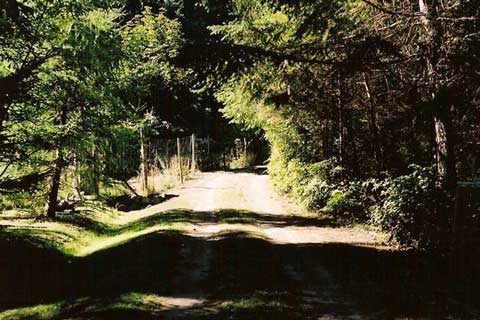
...and turn up the driveway to his secluded rural home.

He'll pop the cap off a cold beer in the kitchen...

...and carry it down to relax in the gazebo by the pond.


Perhaps he'll take up gardening.






You know what they say about stopping to smell the flowers?


Or perhaps he'll buy a horse to roam the lower field. He could ride it on island patrol and be a mounted Mountie.
Wouldn't that be good for community relations?

Or perhaps he'll write a police thriller.
For some mysterious reason, there's a stone circle in the woods between the garden and the field.

It's like the stone circles you'll find throughout Britain and Ireland (culminating in Stonehenge).

Swinside stone circle in Britain's Lake District
Photo by Richard Mudhar (licensed copyright)
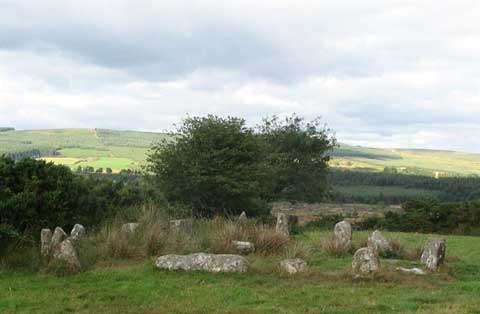
Carrigagulla stone circle in Ireland
Nick knows a writer who once spent a night in a spooky Rhode Island graveyard, sitting on the same tomb that both Poe and Lovecraft sat on before. Out of that experience came his thriller GHOUL. The same fool also got himself cursed in a South Seas cannibal cave. That spawned BED OF NAILS.
What if Nick were to spend a full-moon night in this stone circle? The burnt bones unearthed in Britain's and Ireland's more than 1,000 stone circles are strong evidence of prehistoric sacrificial rites. Who knows what plot might come to a writer who conjures those dark forces?

Or perhaps he'll take up sailing...

"Be careful what you wish for," warns the Chinese proverb.
Those islands on the horizon aren't as benign as Nick might think, for Mephisto has diabolic plans to use the diminishing corporal as a pawn to force C/Supt. DeClercq to find the Highland Hoard.
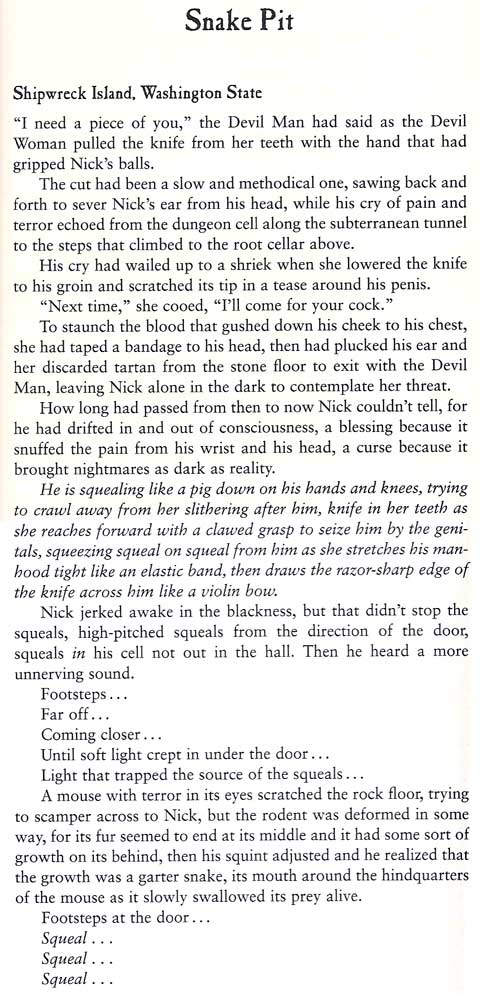
It takes a supercop to hunt an archvillain. So meet Detective Inspector Kim Rossmo.

Rossmo hunting the hunters (photo by Vancouver Magazine)
At this point, the story picks up on the end of RIPPER.
On November 20, 1994, Slade received a letter:
"I am writing to tell you how much I enjoyed reading RIPPER...It was most intriguing to read, in a work of fiction, about the use of spatial analysis in a serial murder investigation. You might be interested to know that analysis of crime site locations has now become an investigative strategy in certain types of serial violent crime cases. Geographic profiling is used to determine the most likely area for offender residence..."
The letter - signed "Kim Rossmo" - was sent from Simon Fraser University. Within a year, Constable Kim Rossmo - a Vancouver Police Department beat cop working skid road while completing his Ph.D. in Criminology - would revolutionize how psycho-hunters stalk serial predators.

Constable Rossmo walking his beat in 1983
Within a year of receiving Rossmo's letter, Slade heard that the constable had been catapulted up through four ranks of the Vancouver Police Department - corporal, sergeant, staff sergeant, and inspector - to Detective Inspector in charge of the VPD's new Geographic Profiling unit.
How's this for a cop's backstory?
Rossmo was a Prairie boy from Saskatoon, Saskatchewan. A math whiz in high school, he wrote his Grade 12 final exam in algebra after just one week of classes and got a perfect score. Chasing bad guys on the streets seemed more thrilling than doing math, so he took a break from university to work as a private detective. His specialty was finding people who didn't want to be found. One day would see him playing the role of a drunk in a tough northern bar, and the next day he'd be a mild-mannered salesman.
He moved to Vancouver to work on a master's degree in Criminology. For practical experience and to earn a living, he joined the VPD and became a skid road cop. Only by giving up sleep could he cover both endeavors, so he'd walk a beat until 2 a.m., work on his thesis in the university lab until dawn, then drive to court and read academic journals until he was called to testify against those he'd busted.
His master's thesis constructed mathematical models to predict how fugitives move around the country to prevent arrest and prison.
For action, Rossmo did emergency responses.

The Vancouver Province catches Rossmo in action
Like most human activities, crime has a geographic logic.
The postman cuts across your lawn; he doesn't use the walk. To buy a jug of milk, you go to the nearest store, not one 10 miles away. That's because you're governed by "the least-effort principle," and your "activity space" is shaped by a mental map tied in predictable ways to your anchor point: your home.
Serial killers follow similar spatial rules. Fear of arrest creates a buffer zone of predictable dimensions before a predator starts to hunt. The farther he goes from home, the less his hunting ground overlaps with his "awareness space," so the less likely he is to hunt for victims and chance getting caught.
That which is predictable can be mathematically quantified. Statistics and logic call it the Rules of Probability.

Vancouver has a notorious skid road (see NEWS). Rossmo spent 8 years patrolling its crime-infested streets, absorbing the rules of probability in how serial offenders commit their crimes, then 2 years on a special task force dealing with prostitution and drugs, then 2 years in organized crime intelligence, then 1 year in crime prevention.
The question that challenged the beat cop's mind was: Could he use a series of crime sites to mathematically predict where a criminal might live? Wheredunit = whodunit?
While on a trip to Japan, Rossmo was staring out the window of the famous Bullet Train when the formula came to him. An hour of scribbling on train napkins put it on paper. For those of you with mathematical minds, here's how you hunt a serial killer in the 21st century.
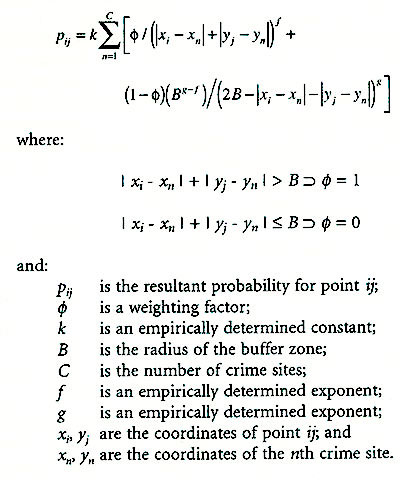
Applying Rossmo's formula to a serial killer case would take up to a million calculations (about 5 years' work), so he created a computer program to run the model. Testing it on known serial killers produced thrilling results. Geographic Profiling tracked each predator to an anchor point - his home or work - within, on average, 5% of his overall killing ground. No wonder Rossmo's doctoral dissertation - GEOGRAPHIC PROFILING: TARGET PATTERNS OF SERIAL MURDERERS (1995) - had the FBI at Quantico, Cambridge University, and others headhunting him.
Slade first met Rossmo in the cybercop office at RCMP Headquarters in 1995. As you can imagine, he was itching to be the first to write Geographic Profiling into a novel. Mephisto offered an ideal setup to showcase Rossmo's creation. Somewhere out there, a sadistic madman is slowly cutting Craven to pieces. The clock is ticking, and DeClercq needs high-tech help.

Rossmo's crime site map of Mephisto's hunting ground
Each time a serial killer meets, attacks, kills, or dumps a victim, he leaves behind a point on a digital map. Rossmo's computer draws a box around the hunting area and divides it into a grid. Then using his formula based on typical journeys to crime sites, Geographic Profiling selects a point on the grid and calculates the distance from it to the first crime site, then to all the other crime sites. Once the probability of that point being the killer's home is computed, the program repeats the action for every other point on the grid.
Next, the system draws contour lines called "isopleths" to link the points with an equal numerical likelihood of being the killer's home. Color-coding the space between the lines creates an amoeba-like geoprofile of the killer's mental map. The hotter the color, the more likely that's where the killer lives.

Rossmo's geoprofile of Mephisto's mental map
To add a third dimension, Geographic Profiling slants the map to convert the isopleths into peaks and valleys. The "height" of each peak represents the probability of the grid space under that color being the killer's home. The 3-D image is called a "jeopardy surface."
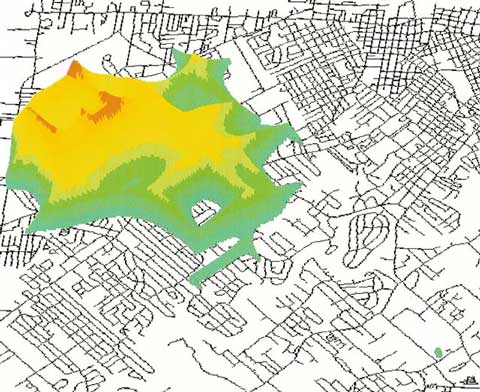
Rossmo's jeopardy surface for the South Side Rapist
The bandit-masked South Side Rapist committed a series of 14 burglary rapes at gunpoint in Lafayette, Louisiana from 1984 to 1995. The trail had gone cold when the bayou cops asked Rossmo to help in 1998. When his geographic profile homed in on a hot zone neighborhood, local detectives surreptitiously obtained DNA from a suspect's discarded cigarette butt. Consequently, a longtime deputy in the Lafayette Parish Sheriff's Office pleaded guilty to the South Side rapes and was sentenced to life in prison.
"I thought he could put us in the ballpark," Lafayette's police chief said of Rossmo on NBC Dateline. "I didn't think he'd give us row and seat."
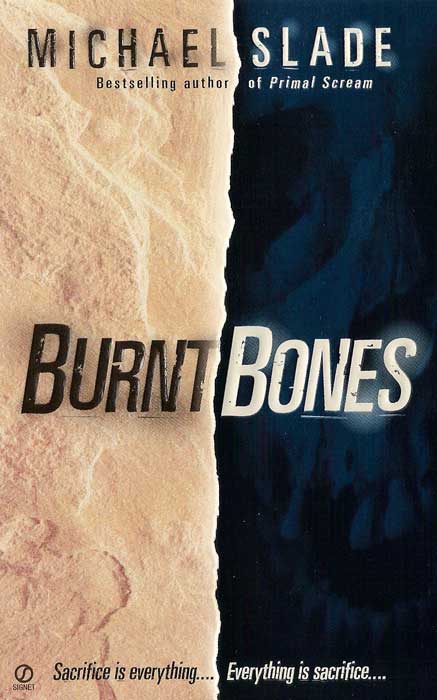
American edition of BURNT BONES
"Top cop Detective Inspector Kim Rossmo had only one condition when asked to be a character in BURNT BONES. 'I asked not to be mutilated,' jokes the psycho-hunter. 'When I got the novel and read it, it was the strangest thing. There you are with your real background. You're working on a case like you really would be, but there's this dialogue going on that you've never said in real life. It was a unique experience.' Rossmo is a Slade fan, partly because the books revel in a kind of ambitiously macabre crime that is a cut above the sad, grim routine a police officer sees. 'They're really interesting reads,' says the cybercop." - The Canadian Press
"Real-life detective Kim Rossmo is a character in BURNT BONES. 'What I thought would happen,' says Slade, 'is that when it came time to edit, Kim would be edited out and a fictional character would be substituted in his place.' Instead, his publisher saw the appeal of a flesh-and-blood character and sent Rossmo out on the book tours with Slade." - The Vancouver Province
"Rossmo's best marketing tool may prove to be his appearance as a character in BURNT BONES, a psycho-thriller by Vancouver lawyer Michael Slade. The Slade books have developed a strong following among police officers because of their strict adherence to proper police procedure. Rossmo hopes the novel will do for Geographic Profiling what SILENCE OF THE LAMBS did for its psychological counterpart. 'I know it works, this invention of yours,' Slade's hero, C/Supt. Robert DeClercq, tells Rossmo in the novel. The difficulty is in convincing real cops." - Reader's Digest, "Mapping Evil"
"Back in Vancouver, when Rossmo was heading up the world's first Geographic Profiling unit, a sign hanging on the office doorknob read, 'Bates Motel: Please Make Up My Room.' But the whimsy in his current office in D.C. is subtler. There's a replica Maltese Falcon on the windowsill; on the bookshelf, a copy of BURNT BONES, the Michael Slade novel in which Rossmo appears as a character. For an excerpt featuring Rossmo, go to the Popular Science Website." - Popular Science, "Hound of the Data Points"
"Slade villains are among the most twisted, evil creations to adorn the printed page. Some can mask their deep psychoses and personality disorders. Others, like the megalomaniacal and murky Mephisto in BURNT BONES, operate outside society, exploiting its weaknesses for personal gain. The crimes are brutal and vicious. Slade works closely with police officers to ensure that he uses state-of-the-art police techniques. Slade has been invited to speak at police conventions because he writes cop thrillers that cops read. Real-life psycho-hunters Det. Insp. Kim Rossmo and S/Sgt. Christine Wozney have stepped into Slade's parallel world as fictionalized versions of themselves. Rossmo allowed himself to be fictionalized on the condition that he not be murdered violently, a wise precaution given the way Slade treats many of his characters. Even the good guys suffer horribly. The nervous tension of Slade novels is enhanced by the realization that no one is safe - any character could be killed or maimed at any time." - Cemetery Dance
BURNT BONES was published in 1999. Between 1995 and 1998, almost 30 women vanished from Vancouver's skid road. In the fall of 1998 - while Slade and Rossmo were at work on BURNT BONES - the cybercop warned the Vancouver Police that a stealth killer was hunting. His warning was ignored. Between then and when Robert Pickton was arrested in 2002, at least 11 more women died (see NEWS).
By spring 2001, Rossmo was director of research at the Police Foundation in Washington, D.C. There, Chief Charles Moose called him in to profile the Beltway Sniper case (John Muhammad and Lee Malvo).
From 2003 on, Rossmo has been a research professor at Texas State University's Department of Criminal Justice, where he occupies the Endowed Chair in Criminology. Police forces around the world have called him in on over 200 serial cases involving about 3,000 crimes. The U.S. government has invested over a million dollars in his proven methodology to hunt active terrorist cells and wartime insurgents, using the locations of terrorism acts or improvised explosive devices (IEDs).
In BURNT BONES, you can watch him match wits with his toughest adversary: Mephisto.
